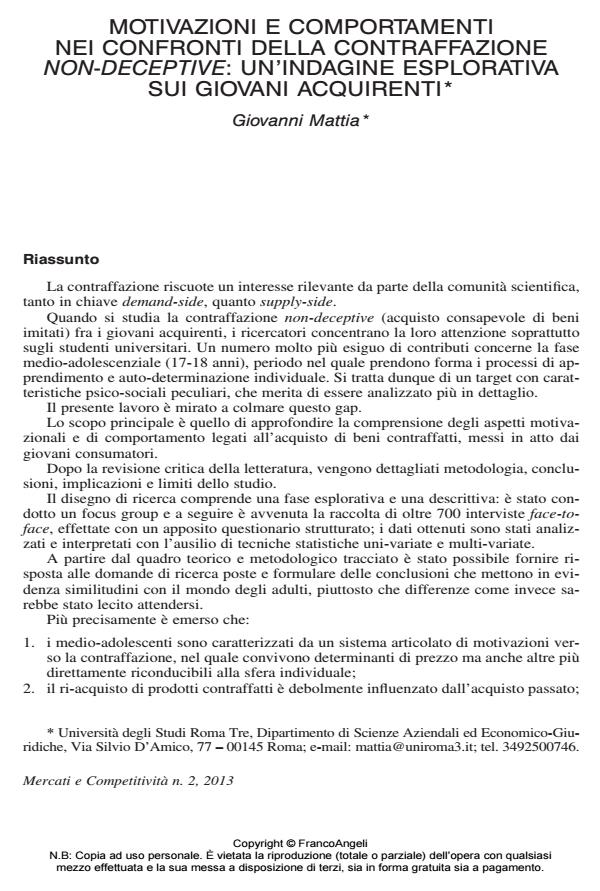Motivazioni e comportamenti nei confronti della contraffazione non-deceptive: un’indagine esplorativa sui giovani acquirenti
Titolo Rivista MERCATI & COMPETITIVITÀ
Autori/Curatori Giovanni Mattia
Anno di pubblicazione 2013 Fascicolo 2013/2
Lingua Italiano Numero pagine 21 P. 83-103 Dimensione file 520 KB
DOI 10.3280/MC2013-002005
Il DOI è il codice a barre della proprietà intellettuale: per saperne di più
clicca qui
Qui sotto puoi vedere in anteprima la prima pagina di questo articolo.
Se questo articolo ti interessa, lo puoi acquistare (e scaricare in formato pdf) seguendo le facili indicazioni per acquistare il download credit. Acquista Download Credits per scaricare questo Articolo in formato PDF

FrancoAngeli è membro della Publishers International Linking Association, Inc (PILA)associazione indipendente e non profit per facilitare (attraverso i servizi tecnologici implementati da CrossRef.org) l’accesso degli studiosi ai contenuti digitali nelle pubblicazioni professionali e scientifiche
La contraffazione riscuote un interesse rilevante da parte della comunità scientifica, tanto in chiave demand-side, quanto supply-side. Quando si studia la contraffazione non-deceptive (acquisto consapevole di beni imitati) fra i giovani acquirenti, i ricercatori concentrano la loro attenzione soprattutto sugli studenti universitari. Un numero molto più esiguo di contributi concerne la fase medio-adolescenziale (17-18 anni), periodo nel quale prendono forma i processi di apprendimento e auto-determinazione individuale. Si tratta dunque di un target con caratteristiche psico-sociali peculiari, che merita di essere analizzato più in dettaglio. Il presente lavoro è mirato a colmare questo gap. Lo scopo principale è quello di approfondire la comprensione degli aspetti motivazionali e di comportamento legati all’acquisto di beni contraffatti, messi in atto dai giovani consumatori. Dopo la revisione critica della letteratura, vengono dettagliati metodologia, conclusioni, implicazioni e limiti dello studio. Il disegno di ricerca comprende una fase esplorativa e una descrittiva: è stato condotto un focus group e a seguire è avvenuta la raccolta di oltre 700 interviste face-toface, effettate con un apposito questionario strutturato; i dati ottenuti sono stati analizzati e interpretati con l’ausilio di tecniche statistiche uni-variate e multi-variate. A partire dal quadro teorico e metodologico tracciato è stato possibile fornire risposta alle domande di ricerca poste e formulare delle conclusioni che mettono in evidenza similitudini con il mondo degli adulti, piuttosto che differenze come invece sarebbe stato lecito attendersi. Più precisamente è emerso che: 1. i medio-adolescenti sono caratterizzati da un sistema articolato di motivazioni verso la contraffazione, nel quale convivono determinanti di prezzo ma anche altre più direttamente riconducibili alla sfera individuale; 2. il ri-acquisto di prodotti contraffatti è debolmente influenzato dall’acquisto passato; 3. l’acquisto di prodotti contraffatti è scarsamente riconosciuto come un comportamento riprovevole. A dispetto di un campione di dimensioni ragguardevoli, l’analisi ha una valenza esplorativa: a causa di vincoli organizzativi ed economici, la selezione delle unità campionarie è avvenuta infatti con criterio non probabilistico.
Parole chiave:Contraffazione non-deceptive; giovani consumatori; comportamento dei consumatori; motivazioni d’acquisto; pratiche di consumo
Giovanni Mattia, Motivazioni e comportamenti nei confronti della contraffazione non-deceptive: un’indagine esplorativa sui giovani acquirenti in "MERCATI & COMPETITIVITÀ" 2/2013, pp 83-103, DOI: 10.3280/MC2013-002005